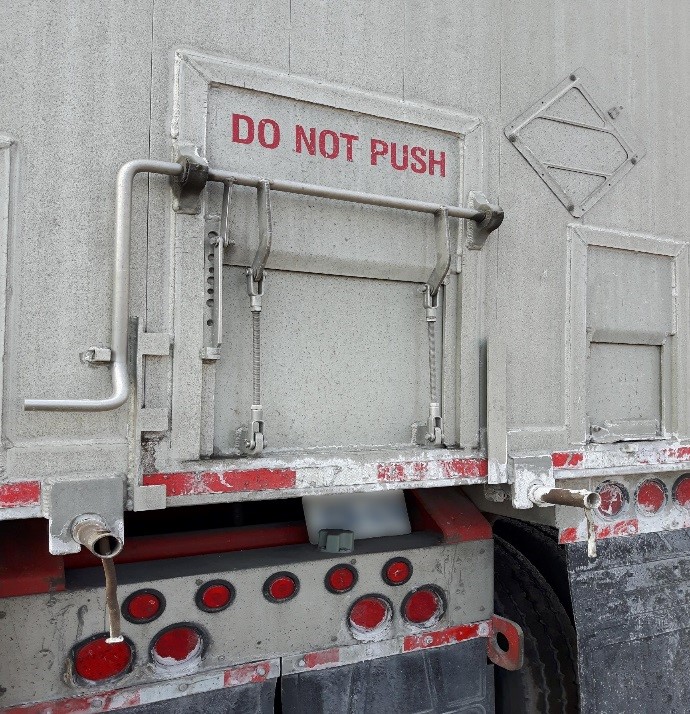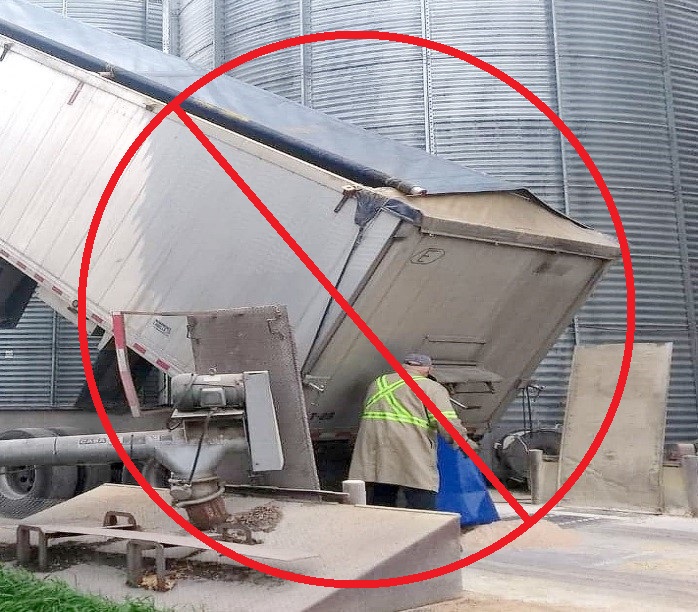Unloading free-flowing material
From: Employment and Social Development Canada
Alternate formats

Unloading free-flowing material [PDF - 417 KB]
Large print, braille, MP3 (audio), e-text and DAISY formats are available on demand by ordering online or calling 1 800 O-Canada (1-800-622-6232). If you use a teletypewriter (TTY), call 1-800-926-9105.
Background
When unloading free-flowing granular material (for example: grain, pellets, flour, wood shavings, sand, track ballast, etc.) with a dump trailer equipped with a swing open dump gate, or those with a grain hatch, the free-flowing material can become clumped or stuck at the top of the container when the trailer is raised. Various tools, such as steel rods or a compressed air blower, can be used, to loosen the free-flowing material and help it pour out. Stuck cargo can suddenly come loose at any time with enough force to tear off the gate and its attachments, especially if the wing nuts or fasteners are missing, not closed, locked or torqued enough. Under such force, an employee standing behind the trailer may be struck by broken pieces or the gate itself, or be thrown against a wall or to the ground. The load can also pour out so quickly that it buries the employee, who may be suffocated or crushed as a result. Any employee standing in the hazard zone can suffer severe or fatal injuries.

Figure 1 – Text version
This picture shows the back of one model of a dump trailer equipped with a grain hatch.

Figure 2 – Text version
This picture shows an example of what should not be done. It represents an employee positioned in the hazard zone directly behind a truck trailer that is raised while it is loaded.
Hazards
Factors that can lead to an accident, death or injury while unloading free-flowing material include:
- the force exerted by the free-flowing material, depending on the characteristics of the product, on the sides of the trailer
- missing, open, unlocked or insufficiently torqued wing nuts or fasteners
- sudden release of the free-flowing material load
- the position of an employee in the hazard zone, for example directly behind the trailer when it is raised
Eliminating and controlling the hazard
Some effective ways to prevent accidents and injuries while unloading free-flowing granular material include:
- ensure that the truck or trailer is appropriate to carry the free-flowing material, according to its characteristics
- ensure that every employee, and every person near the operation, is fully informed about the risks to which they are exposed, including the risk of spills and being buried alive, for example with the use of posters or information on load manifests
- ensure that employees are trained about the risks to which they are exposed and how to avoid them, including the risk of spills and being buried alive; employers under federal jurisdiction can ensure that truck drivers employed by a third party are trained when establishing the business contract or through other means
- implement safety procedures for unloading free-flowing material
- establish safety procedures for safely using a steel rod; or a compressed air blower based on the type and characteristics of the blower used
- know the employer’s hazard prevention program and understand how it applies on client work sites, for example hazard zones
The most effective way of preventing this type of accident is to:
- ensure that employees never stand behind a raised truck trailer when it is loaded
- ensure all wing nuts or fasteners are closed, locked and sufficiently torqued when unloading a truck trailer with a swing open dump gate
- ensure that there are no employees in a hazard zone or prohibited zone when any free-flowing material is being unloaded
Legislative requirements
Employees must protect the health and safety of employees involved in unloading a truck, regardless of the location. Part II of the Canada Labour Code (the Code) extends beyond the conventional work place; subsection 125(1) requires that employers ensure that the health and safety of employees is protected while conducting all work activities.
Paragraph 125(1)(y) of the Code stipulates that employers must ensure that the activities of every person granted access to the work place do not endanger the health and safety of employees.
Paragraph 125(1)(z.14) of the Code stipulates that employers must ensure that all of the persons granted access to the work place – other than the employer’s employees – are informed of every known or foreseeable hazard to which they are likely to be exposed in the work place.
The Hazard Prevention Program, found in Part XIX of the Canada Occupational Health and Safety Regulations (COHSR), requires employers to identify hazards in the workplace. The Labour Program’s Hazard Prevention Program Guide offers support in implementing a hazard prevention program that complies with Part XIX of the COHSR.
To protect employees’ health and safety on site during unloading of free-flowing material, employers must consult the policy health and safety committee (if applicable), the work health and safety committee, or a health and safety representative to:
- identify and assess the hazards associated with work on unknown worksites
- identify and assess the hazards associated with unloading free-flowing material
- implement suitable control measures to prevent identified hazards, such as establishing prohibited zones during unloading or asking employees not to take part in operations
- train drivers on safe working procedures relating to unloading trailers
- train employees on how to safely use required equipment, such as a steel rod or a compressed air blower
Additional resources
For further information, please contact the ESDC Labour Program Office at 1-800-641-4049. The Labour Program website provides information on occupational health and safety topics such as: Right to Know, Right to refuse dangerous work, and Workplace Health and Safety Committees.